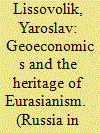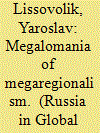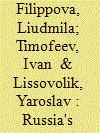| Srl | Item |
| 1 |
ID:
151539


|
|
|
|
|
| Summary/Abstract |
When discussing Russia's pivot to the East and its key foreign economic priorities, it is important to remember Russian economic thought of the last century, the relevance and merits of which are yet to be studied. Conceived almost a hundred years ago, the theory of Eurasianism has played an important role in exploring transcontinental alliances and economic interaction between Europe and Asia. The theory holds that Russia's development should be based on what makes it distinct from other countries; namely, its geographical, historical, cultural, and economic peculiarities. Russia can advance economically by taking advantage of its geographical position between Europe and Asia as interaction intensifies between these two focal points of the global economy.
|
|
|
|
|
|
|
|
|
|
|
|
|
|
|
|
| 2 |
ID:
143122


|
|
|
|
|
| Summary/Abstract |
At the beginning of October 2015 the world map of trading and economic alliances underwent an unprecedented transformation with the conclusion of the Trans-Pacific Partnership (TPP) agreement. The Trans-Pacific Partnership is the largest regional integration group in the Pacific region built on the basis of a free trade zone. The TPP accounts for almost 40 percent of the global GDP and for nearly a third of world trade flows. Using the term coined by Vladimir Lenin, the TPP can be described as "the highest stage of regionalism," for it heralds the emergence of the first transcontinental integration group. The event will have drastic effects on trade and investment flows, and not only those in the vast expanses of the Pacific, but also on the global scale.
|
|
|
|
|
|
|
|
|
|
|
|
|
|
|
|
| 3 |
ID:
155243


|
|
|
|
|
| Summary/Abstract |
The article aims to highlight Russian approaches to Chinese One Belt-One Road initiative. It examines possible opportunities and challenges for co-development of the Eurasian Economic Union and the Belt project. Both projects and their co-development may reduce the uncertainty in Eurasia, caused by significant structural changes in international relations and the world economy, the emergence of new trade regimes and the erosion of leadership in international affairs. Russian interests in this regard are determined by the need for modernization and long-term development, which could also help to address acute security issues. These particular factors encouraged Russia to come up with an ambitious plan of the Extensive Eurasian Partnership, although the prospects of its implementation currently are uncertain. The present article argues that the success of Russia-China collaboration in Eurasia will depend crucially on the future dynamics of the Eurasian integration, as well as on the agreement to co-develop the Eurasian Economic Union and the Belt Initiative with concrete and mutually beneficial projects.
|
|
|
|
|
|
|
|
|
|
|
|
|
|
|
|